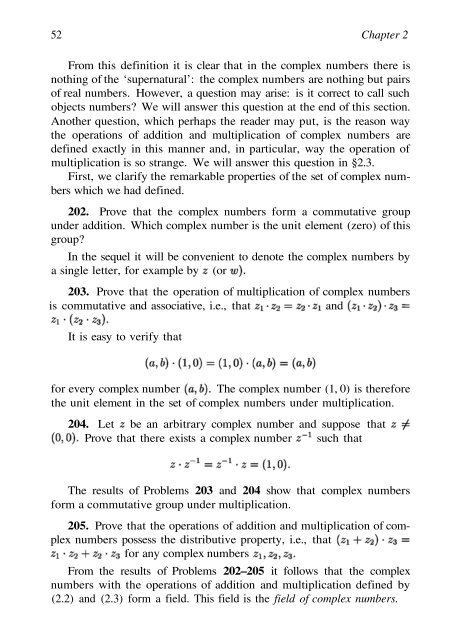Abel's theorem in problems and solutions - School of Mathematics
Abel's theorem in problems and solutions - School of Mathematics
Abel's theorem in problems and solutions - School of Mathematics
You also want an ePaper? Increase the reach of your titles
YUMPU automatically turns print PDFs into web optimized ePapers that Google loves.
52 Chapter 2<br />
From this def<strong>in</strong>ition it is clear that <strong>in</strong> the complex numbers there is<br />
noth<strong>in</strong>g <strong>of</strong> the ‘supernatural’: the complex numbers are noth<strong>in</strong>g but pairs<br />
<strong>of</strong> real numbers. However, a question may arise: is it correct to call such<br />
objects numbers? We will answer this question at the end <strong>of</strong> this section.<br />
Another question, which perhaps the reader may put, is the reason way<br />
the operations <strong>of</strong> addition <strong>and</strong> multiplication <strong>of</strong> complex numbers are<br />
def<strong>in</strong>ed exactly <strong>in</strong> this manner <strong>and</strong>, <strong>in</strong> particular, way the operation <strong>of</strong><br />
multiplication is so strange. We will answer this question <strong>in</strong> §2.3.<br />
First, we clarify the remarkable properties <strong>of</strong> the set <strong>of</strong> complex numbers<br />
which we had def<strong>in</strong>ed.<br />
202. Prove that the complex numbers form a commutative group<br />
under addition. Which complex number is the unit element (zero) <strong>of</strong> this<br />
group?<br />
In the sequel it will be convenient to denote the complex numbers by<br />
a s<strong>in</strong>gle letter, for example by (or<br />
203. Prove that the operation <strong>of</strong> multiplication <strong>of</strong> complex numbers<br />
is commutative <strong>and</strong> associative, i.e., that <strong>and</strong><br />
It is easy to verify that<br />
for every complex number The complex number (1, 0) is therefore<br />
the unit element <strong>in</strong> the set <strong>of</strong> complex numbers under multiplication.<br />
204. Let be an arbitrary complex number <strong>and</strong> suppose that<br />
Prove that there exists a complex number such that<br />
The results <strong>of</strong> Problems 203 <strong>and</strong> 204 show that complex numbers<br />
form a commutative group under multiplication.<br />
205. Prove that the operations <strong>of</strong> addition <strong>and</strong> multiplication <strong>of</strong> complex<br />
numbers possess the distributive property, i.e., that<br />
for any complex numbers<br />
From the results <strong>of</strong> Problems 202–205 it follows that the complex<br />
numbers with the operations <strong>of</strong> addition <strong>and</strong> multiplication def<strong>in</strong>ed by<br />
(2.2) <strong>and</strong> (2.3) form a field. This field is the field <strong>of</strong> complex numbers.

















